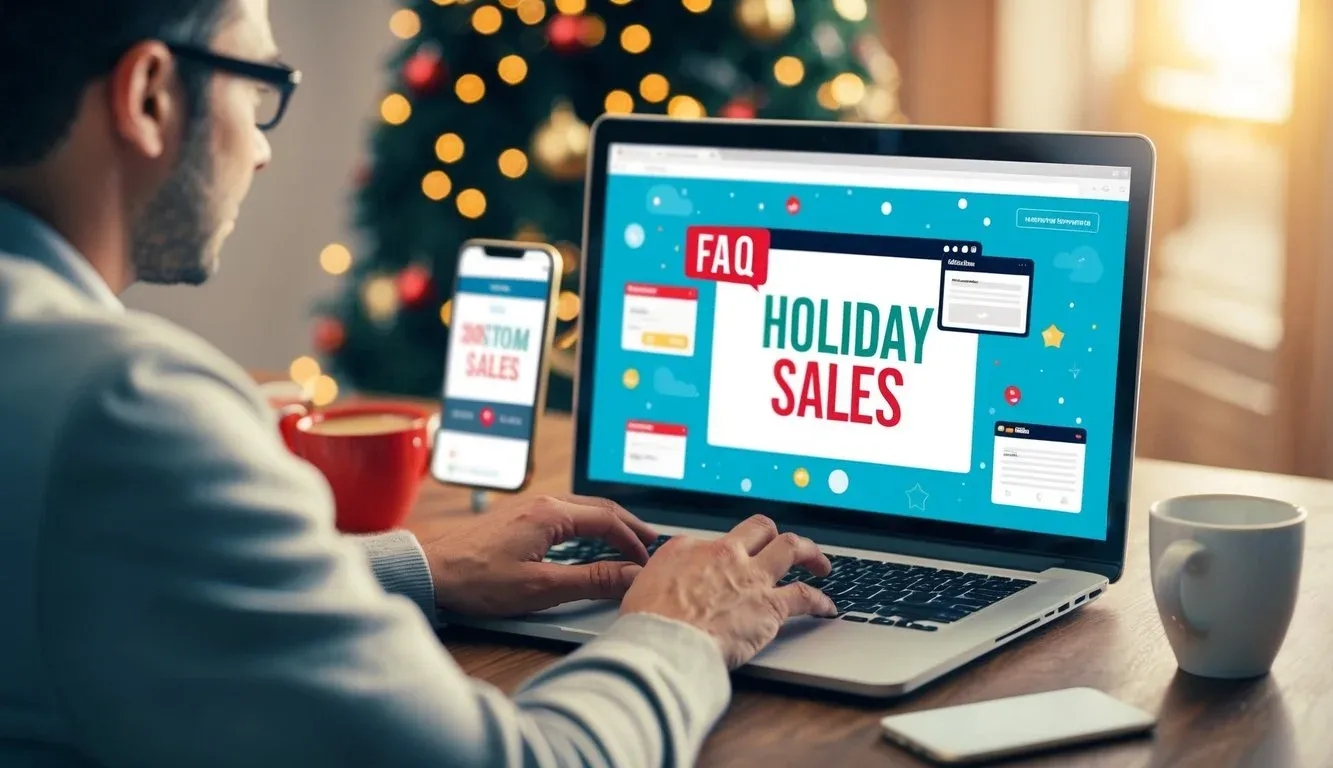Holiday Shopping Trends: Ecommerce Insights and Predictions

Online holiday shopping continues to reach new heights as more consumers embrace digital purchasing. The shift towards e-commerce has created exciting opportunities for retailers to connect with shoppers in innovative ways.

Digital retailers are adapting to meet changing consumer needs with improved shopping experiences. Mobile shopping, same-day delivery, and personalized recommendations have become standard features that shoppers expect during the busy holiday season.
The rise of social commerce and live shopping events adds new dimensions to holiday e-commerce. These platforms create engaging ways for brands to showcase products and connect with customers while making purchasing quick and simple.
Key Takeaways
- E-commerce sales continue strong
- Digital shopping platforms now integrate social media, mobile apps, and personalized experiences
- Retailers prioritize fast delivery options and seamless shopping experiences to meet consumer demands
Evolving Consumer Behavior and Expectations
Consumer shopping patterns have changed dramatically in the past year, with digital-first buying habits and price sensitivity shaping the 2024 holiday season. Shoppers now make more calculated purchasing decisions while seeking personalized experiences.
Gen Z and Millennials' Influence
Gen Z and Millennials make up 46% of holiday shoppers in 2024, driving significant changes in retail expectations. These groups prioritize mobile shopping and demand seamless digital experiences.
They show strong preference for brands that align with their values, particularly sustainability and social responsibility. 72% research products extensively before buying.
Social media plays a crucial role in their purchase decisions. Instagram and TikTok influence 65% of their holiday gift choices.
Shifts in Shopping Behaviors
Digital wallets and buy-now-pay-later options have seen a 35% increase in usage during holiday shopping. Mobile purchases now account for 63% of online holiday sales.
Shoppers start their holiday buying earlier, with 40% beginning before October. Supply chain concerns drive this early shopping trend.
Key Shopping Changes:
- More research before purchases
- Increased use of price comparison tools
- Higher demand for same-day delivery
- Greater emphasis on digital gift cards
Impact of Inflation on Holiday Spending
Average holiday budgets have decreased by 12% compared to previous years. Shoppers focus more on essential items and practical gifts.
Price-conscious consumers actively seek deals and promotions. 82% use discount codes or wait for sales before making purchases.
Budget-Friendly Shopping Strategies:
- Bulk buying to save money
- Focus on store brands
- Increased use of loyalty programs
- Strategic timing of purchases during sales events
The Digital Shopping Landscape
Digital shopping continues to transform how people browse and buy products. New technologies and shifting consumer behaviors shape the way brands connect with customers across multiple channels.
Growth of Ecommerce
Online shopping has seen massive growth in recent years. Digital sales now make up over 20% of total retail purchases worldwide.
More consumers start their holiday shopping early, with 22% beginning as early as August to manage expenses and avoid price surges.
Year-round holiday shopping is becoming common. By 2026, 30% of shoppers plan to spread their winter gift purchases throughout the year.
Importance of a Seamless Mobile Experience
Mobile devices drive the majority of ecommerce traffic. Over 70% of online shoppers use smartphones to research products and make purchases.
Speed and ease-of-use on mobile sites directly impact sales. Websites that load in under 3 seconds see 50% higher conversion rates.
Key mobile features that boost sales:
- One-click checkout
- Digital wallets
- Responsive design
- Easy navigation
The Omnichannel Approach
Successful brands integrate their online and offline presence. Customers expect consistent experiences across all shopping channels.
Popular omnichannel services include:
- Buy online, pick up in store
- Mobile app ordering
- Cross-channel inventory visibility
- Unified loyalty programs
Data shows that omnichannel customers spend 15-30% more than single-channel shoppers. This integrated approach helps brands create stronger customer relationships and increase sales.
Sales Events and Promotional Strategies

Holiday ecommerce sales thrive on strategic promotions and flexible payment options. Smart retailers leverage key shopping events and targeted discounts to maximize revenue during peak seasons.
Black Friday and Cyber Monday Highlights
Online retailers saw record-breaking sales during Black Friday and Cyber Monday 2024, with global consumers spending $211.7 billion over the four-day weekend.
Mobile shopping dominated these events, with 70% of purchases made through smartphones and tablets.
Early-bird deals started appearing up to two weeks before Black Friday, creating an extended shopping period that helped spread out order volume.
Effective Use of Discounts and Bundle Deals
Flash sales generate excitement and urgency, typically running for 4-8 hours with discounts of 20-40% off select items.
Product bundles combine complementary items at a 15-25% discount compared to individual purchase prices. These deals increase average order values while clearing inventory.
Limited-time offers work best when paired with countdown timers and clear messaging about savings. Popular formats include:
- Buy-one-get-one deals
- Free shipping thresholds
- Tiered discounts on minimum purchase amounts
Emergence of Buy Now, Pay Later (BNPL)
BNPL services now appear at checkout on 60% of major retail sites.
These payment options split purchases into 4-6 interest-free installments, making larger holiday purchases more accessible to budget-conscious shoppers.
Merchants offering BNPL report 20-30% higher average transaction values and reduced cart abandonment rates during peak shopping periods.
Marketing and Customer Engagement Techniques
Effective marketing and customer engagement drive holiday sales through targeted social media campaigns, personalized email content, and customer-driven recommendations. These strategies create meaningful connections with shoppers and boost conversion rates during peak shopping seasons.
Social Media and Influencer Marketing
Social media platforms serve as essential channels for reaching holiday shoppers. Brands need to create engaging, seasonal content across Instagram, TikTok, and Facebook to showcase products and special offers.
Influencer partnerships amplify brand reach during the holiday season. Working with content creators who align with brand values helps build trust and authenticity.
Key Social Strategies:
- Share user-generated content featuring holiday gift ideas
- Create shoppable posts with direct purchase links
- Host live shopping events with influencer demonstrations
- Run time-sensitive flash sales through social stories
Email Marketing and Personalization
Email campaigns remain a powerful tool for driving holiday sales. Segmented lists allow brands to send targeted messages based on shopping history and customer preferences.
AI-powered personalization tools help create custom product recommendations and tailored offers. Smart email automation ensures timely delivery of abandoned cart reminders and holiday promotions.
Email Campaign Tips:
- Send early-bird specials to loyal customers
- Create gift guides based on past purchases
- Use countdown timers for limited-time offers
- Set up automated shipping update notifications
Leveraging Customer Reviews and Product Recommendations
Customer reviews build trust during the busy holiday shopping season. Displaying verified purchase reviews helps shoppers make confident buying decisions.
Smart recommendation engines suggest complementary products based on browsing behavior. These tools increase average order value and improve the shopping experience.
Review Management Best Practices:
- Display recent reviews prominently
- Highlight five-star feedback on popular items
- Respond quickly to customer questions
- Feature authentic customer photos with reviews
Logistics and Fulfillment Adaptations

Supply chain changes and customer expectations require retailers to adapt their shipping and fulfillment strategies. Digital sales now connect with physical stores to create smoother delivery experiences.
Navigating Longer Shipping Times
Peak holiday periods put extra strain on shipping networks. Smart retailers stock up 3-4 months before major shopping dates to avoid delays.
Businesses now set earlier shipping cutoff dates for guaranteed holiday delivery. Most recommend placing orders by December 10 for standard shipping to ensure Christmas arrival.
Multiple shipping options give customers flexibility. Free shipping remains popular, but many shoppers choose expedited delivery for last-minute purchases.
Real-time tracking updates help manage customer expectations. Clear communication about potential delays builds trust and reduces support inquiries.
The Role of Brick-and-Mortar Stores in Ecommerce
Physical stores now serve as mini distribution centers. This setup cuts shipping times by fulfilling online orders from the nearest retail location.
Buy online, pick up in store (BOPIS) grew 28% in 2024. This service appeals to shoppers who want items quickly without shipping fees.
Stores offer easy returns for online purchases. 65% of customers check return policies before buying, making convenient options essential.
Mobile apps help connect online and offline shopping. Features like inventory checking and in-store navigation create a seamless experience.
Sustainability and Ethical Considerations

Green practices and ethical business standards have become essential factors in holiday shopping decisions. Shoppers actively seek out brands that demonstrate environmental responsibility and ethical sourcing practices.
Consumer Expectations of Sustainability
Modern shoppers prioritize eco-friendly packaging, sustainable shipping methods, and ethically sourced products. A significant 73% of consumers check product labels for environmental impact information before making purchases.
Companies that display clear sustainability certifications and ethical sourcing information on their websites see 45% higher conversion rates during holiday seasons.
Shoppers want detailed information about:
- Carbon footprint of shipping options
- Recycled packaging materials
- Fair labor practices
- Sustainable material sourcing
- Local production options
Ecommerce's Response to Sustainability Trends
Many online retailers now offer plastic-free packaging alternatives and carbon-neutral shipping choices. Major platforms have created special sections for eco-friendly products.
New features helping shops meet green standards:
- Carbon footprint calculators
- Sustainable packaging options
- Ethical sourcing certificates
Businesses use AI systems to optimize delivery routes and reduce emissions. Some platforms show sustainability scores for products, making it easier for shoppers to make informed choices.
Local delivery options and consolidated shipping programs have reduced package waste by 35% since 2023.
Frequently Asked Questions

Online holiday shopping continues to grow at record rates, with mobile purchases, early-bird deals, and personalized experiences leading the way.
Q: How have holiday shopping trends evolved in recent years?
Shoppers now start their holiday purchases earlier, often beginning in October. Many consumers prioritize retailers that offer flexible payment options like buy-now-pay-later services.
Digital wallets and contactless payments have become standard features expected by holiday shoppers. Free shipping and easy returns rank as top factors in purchase decisions.
Q: What are the peak days for online sales during the holiday season?
Black Friday and Cyber Monday remain the biggest online shopping days of the holiday season. Prime Day-style events in October have created new peak shopping periods.
The week before Christmas sees significant last-minute digital purchases, especially for gift cards and digital products.
Q: Which product categories see the most significant increase in sales over the holidays?
Electronics and tech gadgets lead holiday sales growth, particularly smartphones and gaming consoles. Home goods and kitchen appliances show strong performance during holiday promotions.
Fashion items and accessories experience major spikes during Black Friday and pre-Christmas sales events.
Q: How does mobile shopping impact holiday e-commerce sales?
Mobile devices account for over 60% of holiday shopping traffic. Apps offer better conversion rates than mobile websites during peak shopping days.
Push notifications and mobile-exclusive deals drive significant impulse purchases during the holiday season.
Q: What strategies are retailers using to boost holiday sales?
Personalized email marketing campaigns target shoppers based on previous purchase history. Early-bird discounts encourage customers to start holiday shopping before traditional peak periods.
Free shipping thresholds and limited-time offers create urgency and increase average order values.
Q: How do consumer behaviors change during the holiday season in terms of online shopping?
Shoppers spend more time comparing prices across multiple websites before making purchases. Gift card sales increase significantly in the final weeks before Christmas.
Cart sizes tend to be larger during holiday shopping, with consumers buying multiple items in single transactions.
Q: Are there any specific shopping days that stand out in the 2024 holiday shopping season?
Absolutely! The shopping day of the year, Black Friday, is still a huge focus, but with the season getting longer, many shoppers are also looking at Cyber Monday and other promotional days throughout November and December. Expect significant online shopping activity on these days!
Q: What role do ecommerce platforms play in shaping holiday sales growth?
Ecommerce platforms are crucial for retailers during the holiday retail sales period. They provide the necessary tools for optimizing online stores, improving customer experiences, and analyzing shopping data to drive sales growth in 2024 and beyond.
Q: How can consumers expect to shop online differently in 2025 compared to previous years?
Consumers will likely enjoy a more personalized online shopping experience in 2025, thanks to advanced analytics and AI. This means better product recommendations and tailored marketing strategies based on individual shopping habits observed in the 2024 holiday shopping season.
Q: What are some emerging trends in ecommerce that retailers should be aware of?
Retailers must keep an eye on trends like social commerce and augmented reality, which are becoming increasingly popular. These trends can enhance the online shopping experience, making it more engaging and interactive for consumers during the holiday season.
Q: How can retailers prepare for the challenges of the upcoming holiday shopping season?
Retailers should focus on optimizing their ecommerce platforms, ensuring their websites can handle increased traffic. Additionally, analyzing data from previous holiday seasons can help them anticipate shopper needs and plan promotions effectively for the 2025 holiday shopping season.
Q: What impact does mobile commerce have on holiday shopping habits?
Mobile commerce is a game-changer for holiday shopping habits. Many shoppers prefer to use their smartphones for browsing and purchasing. Retailers must ensure their online stores are mobile-friendly to capture this audience effectively.
Ready for the 2025 Holiday Rush?
Join our mini-course at WAH Academy and get tips how to prep your store, track trends, and launch smart campaigns that boost holiday sales.
No fluff. Just real strategies to help you stay ahead this season.
Tap the button and start getting holiday-ready today.



